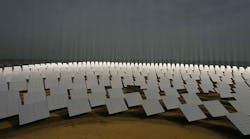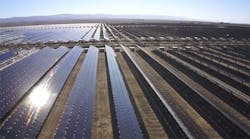Solar Manufacturers Pivoting Away From Big U.S. Utility Projects
The top two U.S. solar manufacturers are shifting away from the biggest domestic market because utilities aren’t signing as many deals to buy electricity from their giant power plants.
SunPower Corp. the No. 2 U.S. panelmaker, said Tuesday it’s turning its attention to rooftop power, while First Solar Inc., the biggest producer, now expects more of its growth to come from selling panels to other companies.
The two companies built some of the biggest solar farms in the world, projects that would never have been completed unless utilities had agreed to buy the power. Because of a shift in tax policy at the end of 2015, those power-plant deals are slowing, which may drag down results.
“Certainly 2017 will be a difficult year in power plants,” SunPower Chief Executive Officer Tom Werner said on a conference call Tuesday. “The power plant market is unlikely to improve in America in the next few quarters. It will in time.”
The culprit is the federal investment tax credit, which for years has been one of the biggest drivers of the U.S. solar industry. It was scheduled to expire at the end of this year, but got an unexpected five-year extension in December. To qualify, construction must begin before the deadline, so developers need to line up a power-purchase agreement, or PPA, many months before that.
No Rush
While the solar industry was pleased, the timing made things tricky. There was a surge of contracts signed in 2015 as companies rushed to meet the earlier deadline. Now there’s no rush, and developers’ pipelines have been depleted.
About 8 gigawatts of big solar farms will go into operation in the U.S. this year, almost double the 4.4 gigawatts in 2015, according to Bloomberg New Energy Finance. That’s the legacy of deals signed in the past. And with utility contracts scarce now, that will slip 11 percent to 7.1 gigawatts in 2017.
“Because the tax credit got extended -- which of course was a good thing -- there’s less of an urgency for utility customers to sign contracts,” Pavel Molchanov, an analyst at Raymond James Financial Inc., said in an interview.
The utility solar market will eventually recover, driven by state clean-energy requirements, global efforts to curb carbon emissions and in the U.S., the investment tax credit.
Headwind, Tailwind
“What is currently a headwind could well become a tailwind in the not-so-distant future,” Molchanov said.
More immediately, SunPower said it expects to lose as much as $175 million this year, a shift from May when it forecast net income of as much as $50 million, largely because demand for utility-scale solar projects is slowing and competition is dragging down panel prices. The company is closing a manufacturing plant in the Philippines and plans to fire 15 percent of his workforce while shifting focus to the rooftop market, where it expects “sustained strong industry growth,” Werner said on the call.
In contrast, the utility segment “did not have enough legacy PPAs to cover the year,” he said. “That was part of the re-guide and that became clear as we got into the second quarter.”
With utilities holding off on power contracts, prices are coming down, according to First Solar CEO Mark Widmar, who was elevated from chief financial officer July 1.
‘Aggressive Pricing’
“We’re seeing a lot of very aggressive pricing behavior in the market,” he said in a conference call Aug. 4. First Solar reduced the sales force dedicated to the utility market and shifted capital expenditures to improving the panels that it sells other developers, an effort that’s expected to boost profit margins.
The company gets about 70 percent of its sales from developing big solar farms for utilities, with the rest coming from providing panels to other developers. By 2019 that ratio will be reversed, former CEO Jim Hughes said in April.
“Utilities seem to be in a wait-and-see mode,” said Hugh Bromley, a solar analyst with New Energy Finance.













